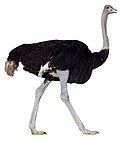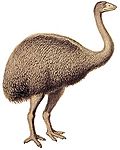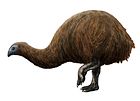| Paracathartes Temporal range: Early Paleocene–Middle Eocene PreꞒ Ꞓ O S D C P T J K Pg N Early Paleocene - Middle Eocene | |
|---|---|
| Scientific classification | |
| Domain: | Eukaryota |
| Kingdom: | Animalia |
| Phylum: | Chordata |
| Class: | Aves |
| Infraclass: | Palaeognathae |
| Order: | †Lithornithiformes |
| Family: | †Lithornithidae |
| Genus: | †Paracathartes (Harrison, 1979) |
| Species | |
Paracathartes is a genus of extinct bird from the Wasachtian horizon of lower Eocene Wyoming. One species, Paracathartes howardae has been described.
It is a paleognathous bird, turkey-like in stature and size, that probably resembled a tinamou quite closely. Unlike other lithornithids but much like its modern relatives it was probably a poor flyer.
Paracathartes was described by Harrison as the earliest known cathartid vulture. Rich criticized this assignment. Houde (1988) included it as a member of the order Lithornithiformes and family Lithornithidae.
The holotype specimen is in the collection of the Royal Ontario Museum. It has catalog number ROM 22658. It is the distal end of a left tibiotarsus. It was collected by G. E. Lindblad and G. Sternberg on 4 August 1949. It was found at the northernmost branch of Elk Creek, near Basin, Wyoming. The horizon is Greybullian, middle Wasatchian (early Eocene), Willwood Formation, Bighorn Basin.
Further specimens of Paracathartes were collected, including almost the whole skeleton (USNM 361402-361446, 391984, 404747-404806) from at least five individuals preserved together. These bones were associated with three whole eggs (USNM 336564) and an avian neurocranium (USNM 361415) which may belong to Paracathartes or to a possible phorusrhacid.
Footnotes
- Hinton, (1996)
- Houde, Peter W. (1988). "Paleognathous Birds from the Early Tertiary of the Northern Hemisphere". Publications of the Nuttall Ornithological Club (Cambridge, MA)
- ^ Harrison, C. J. O. (1979)
- Rich, P. V. (1983)
- Houde, Peter W. (1988)
References
- Harrison, C. J. O. (1979). "A new cathartid vulture from the lower Eocene of Wyoming". Tertiary Research Special Papers. 5: 29–39.
- Hinton, A. C.; Lang, W. D.; et al. (1996). Edwards, Marcia A. (ed.). Nomenclator Zoologicus. Vol. 9. Regents Park, London: Zoological Society of London. p. 479.
- Houde, Peter W. (1988). "Paleognathous Birds from the Early Tertiary of the Northern Hemisphere". Publications of the Nuttall Ornithological Club. 22. Cambridge, MA.
- Rich, P. V. (1983). "In Vulture biology and management". In Wilbur, S. R.; Jackson, J. A. (eds.). The fossil history of vultures: A world perspective. Berkeley, CA: University of California Press. pp. 3–25.
| Taxon identifiers | |
|---|---|
| Paracathartes | |


